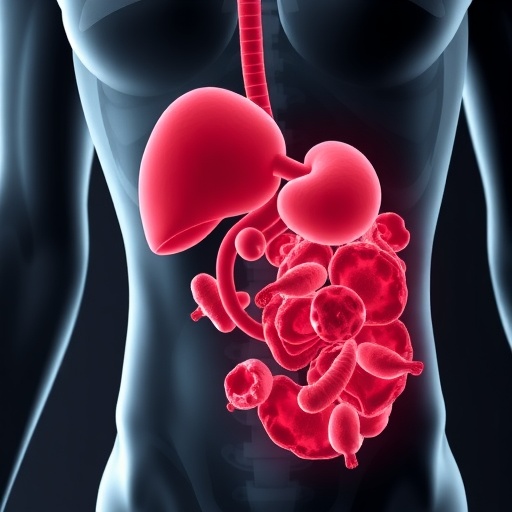A groundbreaking study published in the latest volume of BMC Psychiatry has illuminated a fascinating biological link between abdominal fat distribution and depression, mediated through an innovative biomarker: the neutrophil-to-high-density lipoprotein cholesterol ratio (NHR). This research taps into complex metabolic and inflammatory pathways to propose a fresh angle on depression’s etiology, potentially reshaping future preventive and therapeutic strategies in mental health.
Depression, a pervasive and debilitating global health issue, has long been associated with various physiological and psychological factors. However, the precise biological mechanisms underpinning these associations remain elusive. The new study harnesses data from the National Health and Nutrition Examination Survey (NHANES), employing robust statistical modeling to dissect the nuanced relationship between fat accumulation in abdominal regions and the prevalence of depression among adults.
The research specifically scrutinizes two distinct adipose tissue compartments: subcutaneous adipose tissue index (SATI) and visceral adipose tissue index (VATI). Visceral fat, which envelops internal organs, has been implicated in metabolic dysfunctions more so than subcutaneous fat, which lies beneath the skin. The investigators sought to understand how these fat depots correlate with depressive symptoms, as measured by the Patient Health Questionnaire-9 (PHQ-9), a standard screening tool.
Intriguingly, analysis revealed a positive correlation between both SATI and VATI with depression, indicating that individuals with greater abdominal adiposity exhibited higher odds of depressive symptoms. Notably, VATI demonstrated a linear association with depression risk, implying a direct increase in depressive symptoms concomitant with visceral fat levels. In contrast, the SATI relationship was nonlinear, suggesting complexities in how subcutaneous fat impacts mental health.
The study’s pièce de résistance lies in unveiling the mediating role of the neutrophil-to-high-density lipoprotein cholesterol ratio (NHR), an emergent biomarker representing systemic inflammation and lipid metabolism. Neutrophils, a type of immune cell, contribute to inflammatory processes, whereas HDL cholesterol is recognized for its anti-inflammatory and protective cardiovascular functions. The ratio essentially reflects a balance between pro-inflammatory and anti-inflammatory states within the body.
Through sophisticated mediation analyses, the researchers demonstrate that NHR partially mediates the association between abdominal fat indices and depression. This finding underscores a plausible mechanistic pathway where excess abdominal fat promotes systemic inflammation, as indexed by NHR, thereby elevating depression risk. The results suggest that inflammation driven by fat accumulation could be a pivotal biological conduit influencing mental health.
Furthermore, subgroup analyses considering demographics, lifestyle habits, and comorbid conditions reinforced the robustness of these associations across diverse population segments. This comprehensive approach enhances confidence in the generalizability and clinical relevance of the findings, highlighting potential targets for intervention in both metabolic and psychiatric domains.
This paradigm-shifting research emboldens an integrated view of mental health that intertwines metabolic health, immune function, and psychological well-being. By spotlighting NHR as a potential biomarker, it paves the way for novel diagnostic and therapeutic avenues that transcend traditional psychiatric frameworks, incorporating cardiovascular and metabolic dimensions.
Crucially, these insights carry significant implications for public health policies and clinical practices. The feasibility of measuring NHR in routine health screenings, combined with monitoring abdominal fat accumulation, may facilitate early identification of individuals at heightened risk for depression, enabling preemptive interventions that address both physical and mental health holistically.
Despite the promising findings, the authors prudently acknowledge the cross-sectional design limits causal inference. Longitudinal studies and clinical trials are necessary to validate and extend these results and to explore whether modifying NHR or abdominal adiposity can effectively mitigate depression risk.
The interplay between metabolism, immunity, and mental health ever more clearly unravels through such pioneering investigations. As researchers continue to decipher these complex biological networks, the hope emerges for more personalized, mechanism-based approaches to preventing and treating depression—potentially transforming outcomes for millions worldwide.
These compelling findings represent a critical step toward elucidating the biochemical undercurrents linking body fat distribution to brain function. The delicate balance of inflammatory and lipid homeostasis, as captured by NHR, stands at the confluence of this emerging narrative, offering promising new biomarkers and therapeutic targets in psychiatry and beyond.
Ultimately, this study invigorates a multidisciplinary dialogue bridging endocrinology, immunology, and psychiatry. It challenges the scientific community to broaden perspectives on depression’s origins and to devise integrated strategies that consider the whole body’s role in mental health—heralding a new era of research and treatment paradigms grounded in the intimate crosstalk between the body and the mind.
Subject of Research: The interplay between abdominal fat distribution and depression, focusing on the mediating role of the neutrophil-to-high-density lipoprotein cholesterol ratio (NHR).
Article Title: Neutrophil-to-high-density lipoprotein cholesterol ratio (NHR) mediates the relationship between abdominal fat index and depression in a cross-sectional study.
Article References:
Wang, Q., Luo, Q. & Tian, Z. Neutrophil-to-high-density lipoprotein cholesterol ratio (NHR) mediates the relationship between abdominal fat index and depression in a cross-sectional study. BMC Psychiatry 25, 1035 (2025). https://doi.org/10.1186/s12888-025-07498-5
Image Credits: AI Generated




